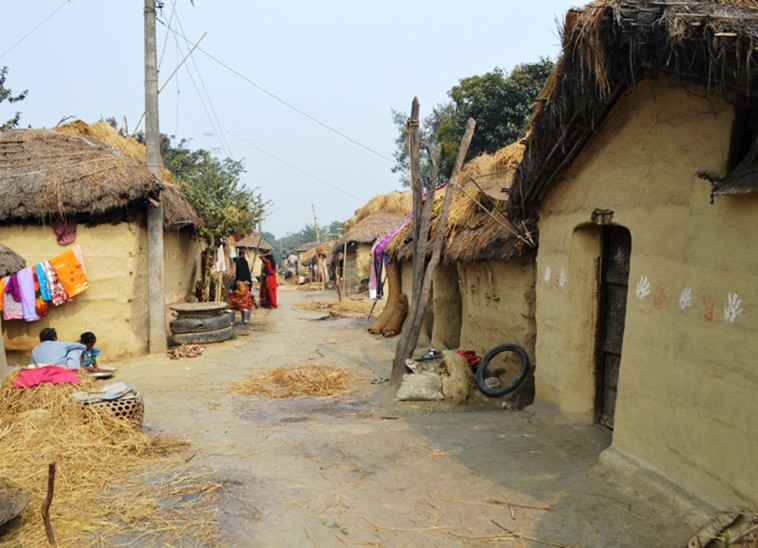
Back in 2011, UN-Habitat had assessed that the housing situation in Nepal was far from adequate, particularly for the urban poor. Increasingly, people living in the cities were unable to afford housing due to rapidly rising land costs.
The formulation of the national housing policy paved the way for ensuring equitable adequate housing for all.
Yet, fast forward to 2023, and the affordable housing situation does not look too different from a decade ago. Half of the Nepali population resides in inadequate housing conditions, while a significant portion of the population lacks access to land ownership.
The need for a secure and affordable home
An adequate home enables families to build a solid foundation for themselves. Mohan, who was a bonded labourer was forced to work on someone else’s land and had no assets to his name.
He partnered with Habitat for Humanity Nepal to build a home 23 years ago. With time, as his family grew, he added more rooms, and they still live in that home in Western Nepal today. With a stable home, Mohan eventually secured a government job as a teacher at a public school. But there are many families like Mohan’s whose situation has not improved in all these years.
The need for secure, affordable homes is more urgent than ever. According to preliminary data from Nepal’s 2021 census that was unveiled in early 2022, 66 per cent of the population lives in urban areas, compared to 17 per cent a decade ago.

As of 2021, all of Nepal’s 293 municipalities are defined as urban areas. While experts are concerned about whether all the municipalities fit the criteria of urban spaces, Nepal is increasingly urbanised. The factors that drive the rate of urbanisation ― rural-urban migration and climate-induced displacement ― are similar to the trend in the Asia-Pacific region.
The influx of people into cities, coupled with natural population growth in urban areas, creates pressure on the limited supply of adequate housing. Under Nepal’s constitution, every citizen has the right to appropriate housing. Yet the delivery of housing is not always equitable, and gaps exist when it comes to the implementation of policies.
Low-income families and marginalised groups such as the Dalits are particularly vulnerable despite the special provisions for land and housing in the constitution. Unable to afford adequate homes and insecure without land tenure, they end up living in substandard housing in hazard-prone areas. They also lack adequate access to water, sanitation, and other basic services.
In some peri-urban and rural areas of the Terai belt, the local governments have committed to allocate plots of government land for the landless in line with the Land Commission’s guidelines and provide grants and technical support through civil society organisations for the construction of decent, affordable homes.
Members of the communities in these administrative units contribute their own labour in building homes and receive joint land entitlements which allow for a sense of ownership and security for their homes. Such efforts are commendable.
The Nepalis are also known for their resilience, given our experiences with the Gorkha earthquake in 2015, floods in 2017, landslides, and the Covid pandemic in 2020.
But we need more than tenacity if Nepal aims to achieve green, inclusive, and sustainable development. We need policymakers and government leaders to break down the systemic barriers that prevent far too many communities and families from realising their potential.
There’s hope for Nepal
With three years to go before 2026 ― when Nepal is set to graduate from the least developed country status ― progress can still be made. A first-of-its-kind study produced by Habitat for Humanity and its research partner, the International Institute for Environment and Development, or IIED, shows the amazing results that could be achieved if housing improvements take place at a massive scale in informal settlements all over the world. The research report was released to mark the launch of Habitat for Humanity’s five-year global advocacy campaign, Home Equals, in mid-May 2023.
The report used a unique modelling methodology, which combines a review of more than 130 articles and reports with 72 indicators across 102 low- and middle-income countries. The model could not generate projections for specific countries on their own, so the researchers grouped countries into four typologies. Assuming the impacts in Nepal reflect those of the country type it is most similar to, improving adequate housing in informal settlements could yield the following potential benefits:
- An increase of between 2.2 per cent and 7.2 per cent in the country’s gross domestic product and gross national income.
- An increase in average life expectancy of between 0.5 per cent and 1.7 per cent.
- An increase in the expected number of years in education by between 8.9 per cent and 15.5 per cent.
Overall, Nepal’s ranking on the Human Development Index could potentially rise by between two and four places. The researchers of the report concluded that ensuring residents of informal settlements have access to adequate housing is not just the right thing to do ― it’s the smart thing to do.
The time to act is now. We can break down barriers to adequate housing through policy solutions for securing land rights, increasing civic participation, building climate resilience, and accessing basic services. Adequate housing is a powerful catalyst for well-being and sustainability. Together, with the government, communities and partners, we can create lasting change.


















